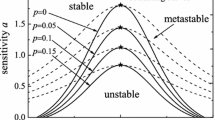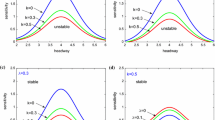Abstract
In this paper, we develop a new car-following model with consideration of varying road condition based on the empirical data. Firstly, we explore the effects of road condition on uniform flow from analytical and numerical perspectives. The results indicate that road condition has great influences on uniform flow, i.e., good road condition can enhance the velocity and flow and their increments will increase when road condition becomes better; bad road conditions will reduce the velocity and flow and their reductions will increase when road condition turns worse. Secondly, we study the effects of road conditions on the starting and braking processes. The numerical results show that good road condition will speed up the two processes and that bad road condition will slow down the two processes. Finally, we study the effects of road condition on small perturbation. The numerical results indicate that the stop-and-go phenomena resulted by small perturbation will become more serious when the road condition becomes better.






Similar content being viewed by others
Notes
Note: we only explore δt and c j during the starting process since they are very complex and depend on many factors during the braking process.
References
Chowdhury, D., Santen, L., Schreckenberg, A.: Statistics physics of vehicular traffic and some related systems. Phys. Rep. 329, 199–329 (2000)
Helbing, D.: Traffic and related self-driven many-particle systems. Rev. Mod. Phys. 73, 1067–1141 (2001)
Bellomo, N., Delitala, M., Coscia, V.: On the mathematical theory of vehicular traffic flow. I—fluid dynamic and kinematic modeling. Math. Models Methods Appl. Sci. 12, 1801–1843 (2002)
Klar, A., Wegener, R.: Traffic flow: models and numerics. In: Modeling and Computational Methods for Kinematic Equations, pp. 219–258. Birkhäuser, Boston (2004)
Lighthill, M.J., Whitham, G.B.: On kinematic waves: II. A theory of traffic flow on long crowed roads. Proc. R. Soc. Lond. Ser. A, Math. Phys. Sci. 229, 317–345 (1955)
Richards, P.I.: Shock waves on the highway. Oper. Res. 4, 42–51 (1956)
Payne, H.J.: Models of freeway traffic and control. In: Bekey, G.A. (ed.) Mathematical Models of Public System. Simulation Councils Proceedings Series, vol. 1, pp. 51–61 (1971)
Jiang, R., Wu, Q.S., Zhu, Z.J.: A new continuum model for traffic flow and numerical tests. Transp. Res., Part B, Methodol. 36, 405–419 (2002)
Wong, G.C.K., Wong, S.C.: A multi-class traffic flow model-an extension of LWR model with heterogeneous drivers. Transp. Res., Part A, Policy Pract. 36, 827–841 (2002)
Gupta, A.K., Katiyar, V.K.: A new multi-class continuum model for traffic flow. Transportmetrica 3, 73–85 (2007)
Bando, M., Hasebe, K., Nakayama, A., Shibata, A., Sugiyama, Y.: Dynamical model of traffic congestion and numerical simulation. Phys. Rev. E 51, 1035–1042 (1995)
Helbing, D., Tilch, B.: Generalized force model of traffic flow. Phys. Rev. E 58, 133–138 (1998)
Nagatani, T.: Stabilization and enhancement of traffic flow by next-nearest-neighbor interaction. Phys. Rev. E 60, 6395–6401 (1998)
Jiang, R., Wu, Q.S., Zhu, Z.J.: Full velocity difference model for car-following theory. Phys. Rev. E 64, 017101 (2001)
Ge, H.X., Dai, S.Q., Dong, L.Y., Xue, Y.: Stabilization effect of traffic flow in an extended car-following model based on intelligent transportation system application. Phys. Rev. E 70, 066134 (2004)
Zhao, X.M., Gao, Z.Y.: A new car-following model: full velocity and acceleration difference model. Eur. Phys. J. B 47, 145–150 (2005)
Wang, T., Gao, Z.Y., Zhao, X.M.: Multiple velocity difference model and its stability analysis. Acta Phys. Sin. 55, 634–640 (2006)
Peng, G.H., Nie, Y.F., Cao, B.F., Liu, C.Q.: A driver’s memory lattice model of traffic flow and its numerical simulation. Nonlinear Dyn. 67, 1811–1815 (2012)
Li, Y., Sun, D., Liu, W., Zhang, M., Zhao, M., Liao, X., Tang, L.: Modeling and simulation for microscopic traffic flow based on multiple headway, velocity and acceleration difference. Nonlinear Dyn. 66, 15–28 (2011)
Tang, T.Q., Wu, Y.H., Caccetta, L., Huang, H.J.: A new car-following model with consideration of roadside memorial. Phys. Lett. A 375, 3845–3850 (2011)
Delitala, M., Tosin, A.: Mathematical modelling of vehicular traffic: a discrete kinetic theory approach. Math. Models Methods Appl. Sci. 17, 901–932 (2007)
Bellouquid, A., Delitala, M.: Asymptotic limits of a discrete kinematic theory model of vehicular traffic. Appl. Math. Lett. 24, 672–678 (2011)
Tang, T.Q., Caccetta, L., Wu, Y.H., Huang, H.J., Yang, X.B.: A macro model for traffic flow on road networks with varying road conditions. J. Adv. Transp. (2011). doi:10.1002/atr.215
Li, C.Y., Tang, T.Q., Huang, H.J., Shang, H.Y.: A new car-following model with consideration of driving resistance. Chin. Phys. Lett. 28, 038902 (2011)
Sarvi, M., Kuwahara, M., Ceder, A.: Observing freeway ramp merging phenomena in congested traffic. J. Adv. Transp. 41, 145–170 (2007)
Ngoduy, D.: Multiclass first order modelling of traffic networks using discontinuous flow-density relationships. Transportmetrica 6, 121–141 (2010)
Ngoduy, D.: Multiclass first-order traffic model using stochastic fundamental diagrams. Transportmetrica 7, 111–125 (2011)
Castillo, J.M.: Three new models for the flow-density relationship: derivation and testing for freeway and urban data. Transportmetrica (2011). doi:10.1080/18128602.2011.556680
Acknowledgements
This study has been supported by the Program for New Century Excellent Talents in University, China (NCET-08-0038), the National Natural Science Foundation of China (70971007), and the WA Centre of Excellence in Industrial Optimization.
Author information
Authors and Affiliations
Corresponding author
Rights and permissions
About this article
Cite this article
Tang, T., Wang, Y., Yang, X. et al. A new car-following model accounting for varying road condition. Nonlinear Dyn 70, 1397–1405 (2012). https://doi.org/10.1007/s11071-012-0542-8
Received:
Accepted:
Published:
Issue Date:
DOI: https://doi.org/10.1007/s11071-012-0542-8




